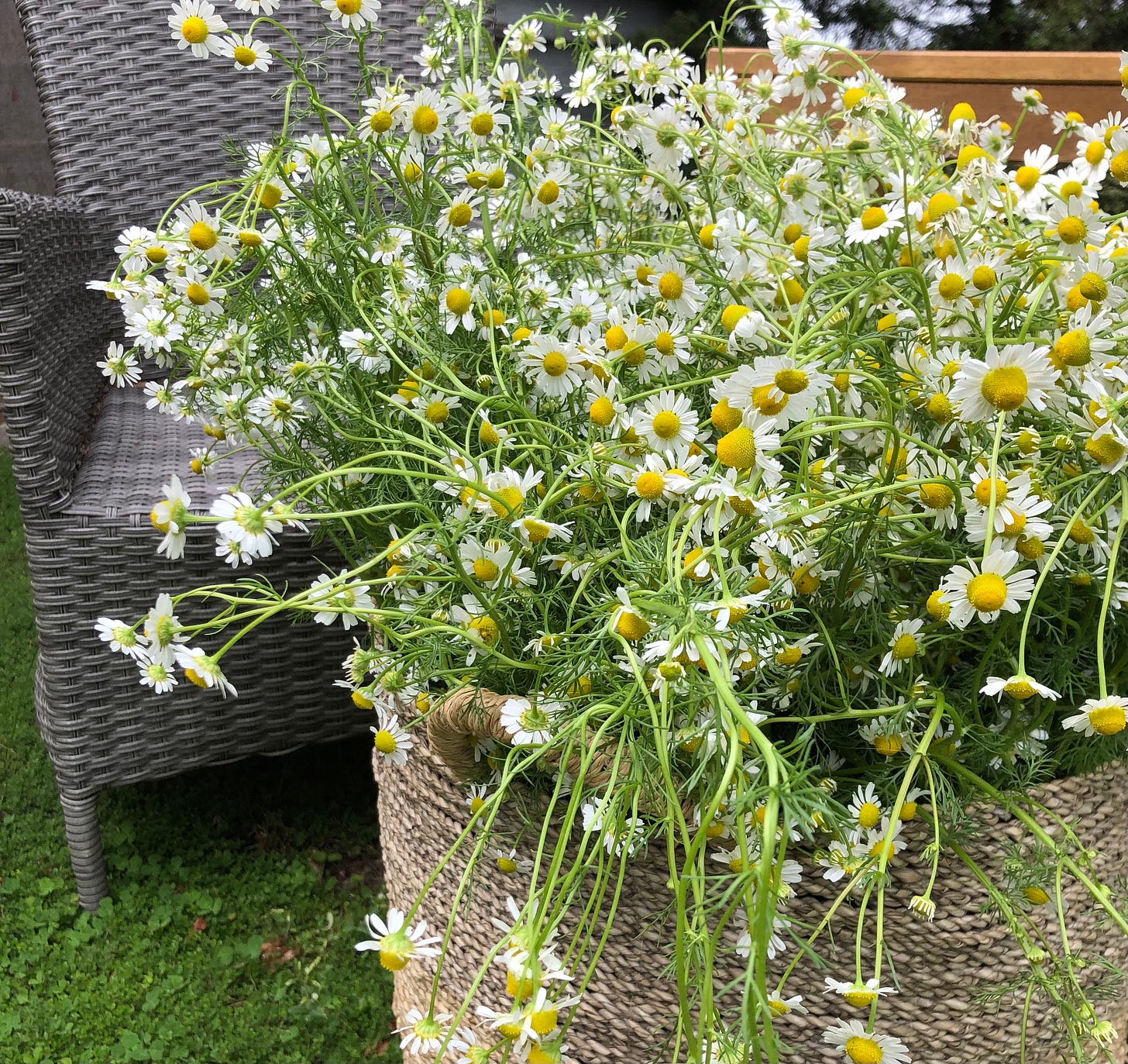What I've Been Harvesting this Past Week... and an Introduction to Plant Safety
You can access an audio recording of the newsletter here
Hello Beautiful Beings,
It’s been a busy week here at home and on the farm. So much is happening this time of year. The lemon balm is ready to harvest. I prefer harvesting lemon balm before it goes to flower, when the leaves are still fresh and green. I find they get weathered and more dried out once the plants have flowered. We also had a great chamomile harvest this week. The flowers are finding their way into herbal tinctures, topical herbal oils and dried as tea.
And the red clover has started to bloom! It’s one of my favourite herbs for tea blends, being a nourishing and mineralizing lymphatic remedy that has traditionally been used for women’s health, osteoporosis prevention, menopause and cancer prevention. Red clover is an herb that is traditionally harvested in its first flush, versus later in the season.
I received a great question about the safety of Horsetail in response to last week’s newsletter. When it comes to the safety of using herbs, there is much to learn. You may like to revisit last week’s post on Horsetail, where in response to the question that came up I have edited the article to clarify a few things around the proper use of the plant.
There are so many nuances when it comes to learning about the plants and how to best use them safely and integrate them into our lives, especially since most of us have not been raised within this tradition. But the tradition is still strong, despite the generations of separation from nature and the plants that we have experienced as a culture - a tradition that is our birthright. The plants call us home to remembering the knowing that we hold deeply in our bones. That we hold through this lineage, through the connection to our ancestors, through the way the earth speaks to us as we walk upon it, through the way the wind whispers to us through the leaves of the trees, and in the soft deer’s footsteps upon the forest floor.
So how do we begin to start learning these nuances? First and foremost is to immerse ourselves in the natural world and in plants that abound. Befriend them, become curious about them, observe them, inhale their scent, watch them as they change their way throughout the seasons. They will start to speak to you.
When you feel drawn to a plant, see if you can learn its name. In order to this we need to learn about how to identify plants correctly. Historically this was done in person directly from someone who knew that particular plants and knew its ways. While the internet offers us access to a lot of information, information overload can be too much and the distraction and disinformation fueled by commercial interests and political agendas often leaves us bewildered. I am hoping that this newsletter is a good first step in becoming familiar with the plants and plant safety within a supportive container that shares trusted and reliable traditional herbal wisdom with you.
When you are looking things up and want to learn more, be discerning about the resources you are turning to. How was this particular plant traditionally harvested, prepared and used? Our herbal knowledge is based on thousands of years of collected experience throughout many cultures and traditions. Make sure you are referring to trusted sources that are based on these traditions. For a place to begin, see my post on a few of My Favourite Herbal Resources and Herbalists. These resources will help us understand the common uses of the plant, confirm that we are using the correct part of the plant, harvesting the plant at the right time of year and preparing it in the best manner.
Of course, the most important thing in using plants safely is learning to identify plants correctly. For some of my favourite resources in this domain, see my previous post on Identifying Plants. Whenever I share a plant with you, I include both the common names as well as the latin name in order to confirm its identity. Most plants have numerous common names, and some plants share common names. Confusing 🙃. As such, the botanical classification and nomenclature of plants is important. The latin name confirms its exact identification and is what we are looking for in the identification process.
Keep in mind that plants fall on a continuum or spectrum that spans from healing foods, to nourishing herbs, to medicinal culinary herbs and spices, through medicinal plants that range from milder to more intense in their physiological effect in the body. Some of the stronger acting plants and plants with potential for toxicity can be used in homeopathic dilution to make sure they are used safely. To give you an idea of this sort of classification I include a pdf of this classification which you can find at the end of the article at this LINK.
So this begins our foray into a deeper understanding of the plants and how to begin to use them with more confidence with our families and in our lives. My hope is that what I share with you reawakens a knowing that lies deep in your bones. A knowing that is intimately entwined with the plants, our connection to them and our place in the the midst of this awe inspiring planet we call home.
Please feel free to continue to share your comments and questions with me. I welcome your response directly to this email if you’d prefer not to comment publicly. I appreciate you taking the time to meet me here in the space where we can explore our place together at the table and in this world.
Much love 💜 Jacinta
Using Herbs Safely: Finding Trusted Resources
Want to learn more about how a particular plant has been traditionally harvested, prepared and used. So much information abounds on the web these days. When you are looking things up and want to learn more, be discerning about the resources you are trusting.
Using Herbs Safely: Identifying Plants
PROPERLY IDENTIFY THE PLANT Herb safety begins with proper identification of plants. The best way to learn plants is in person. When that is not possible, there are many available resources that can help in the identification process. Triple check your sources to verify that you indeed have the correct plant. If there is any risk of the plant being mist…
Spring Horsetail
Common Horsetail (Equisetum arvense), also called Field Horsetail or Bottlebrush, is a perennial of a very old and prehistoric class of plants that reproduce by spores rather than seeds. Horsetail is a mineralizing nutritive tonic high in silica that grows abundantly in this region. Traditionally harvested in the Spring, it is now at its peak for harve…
Using Herbs Safely: An Introduction to Plant Safety and Our Herbal Lineage
There are so many nuances when it comes to learning about the plants and how to best use them safely and integrate them into our lives, especially since most of us have not been raise…








